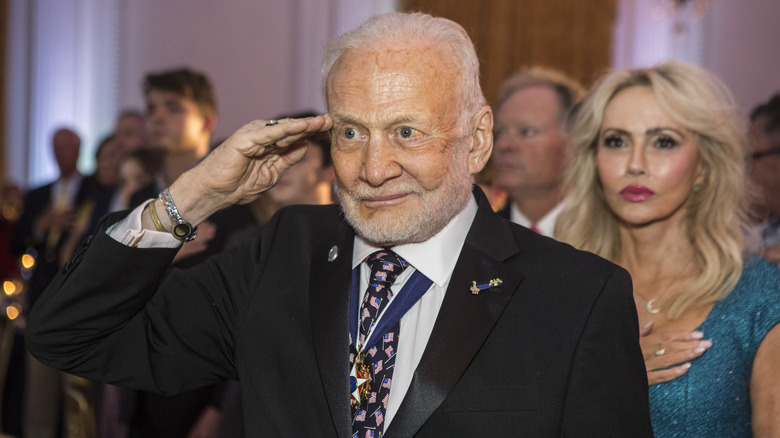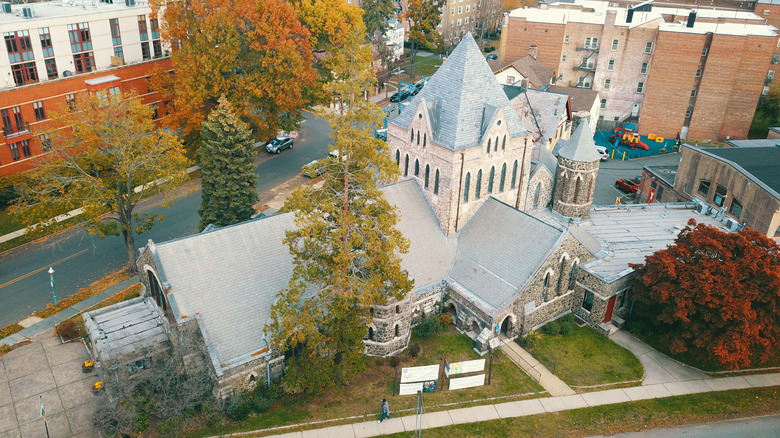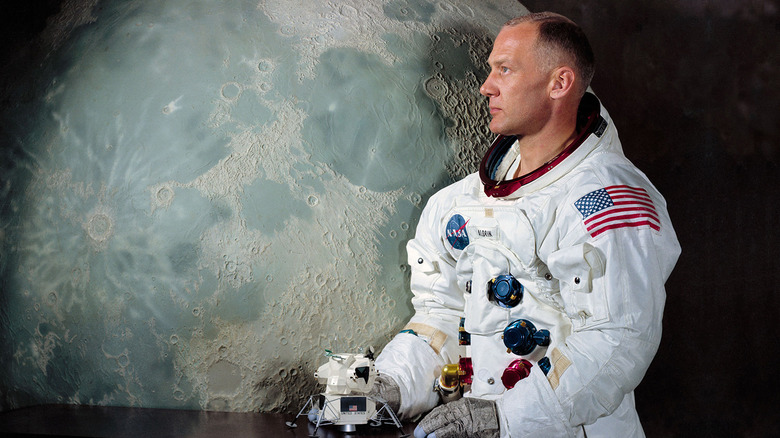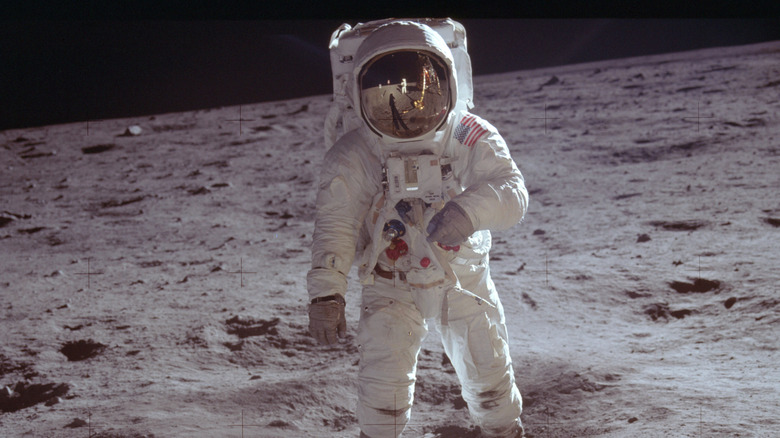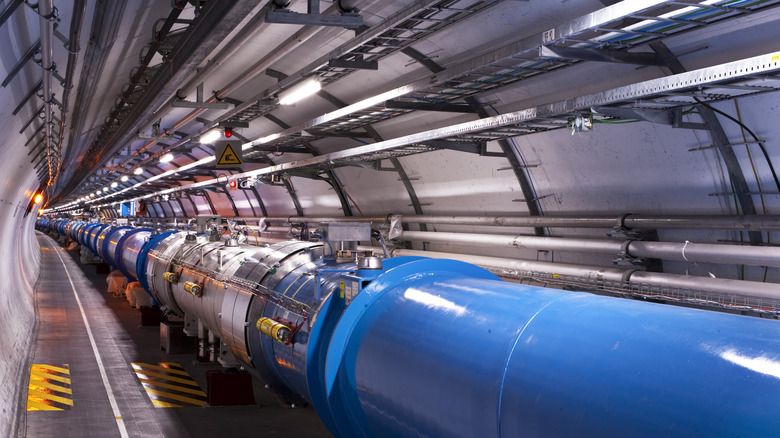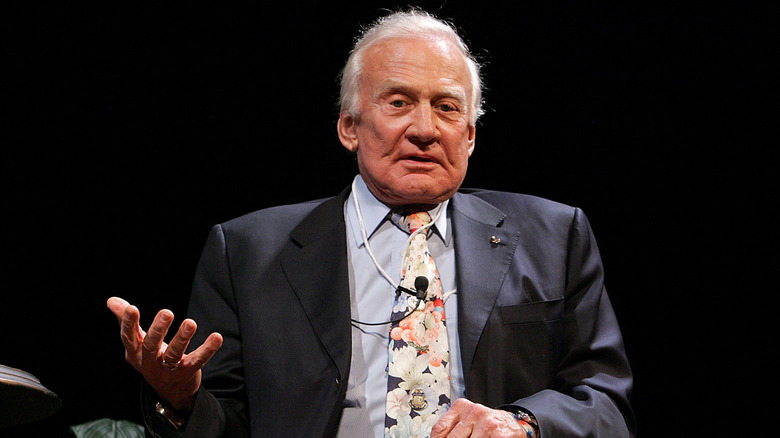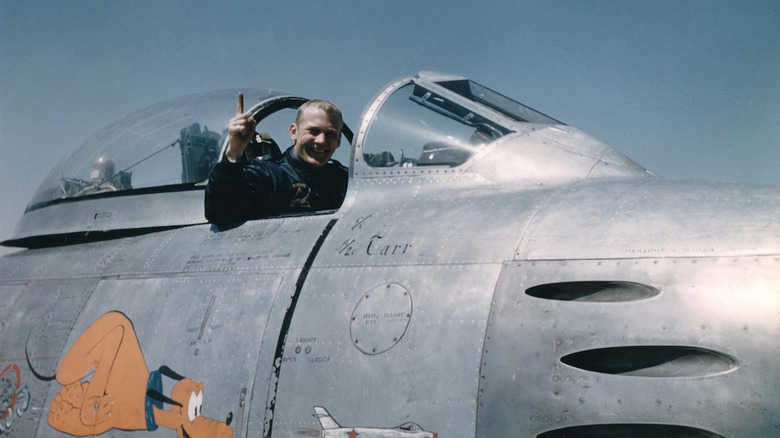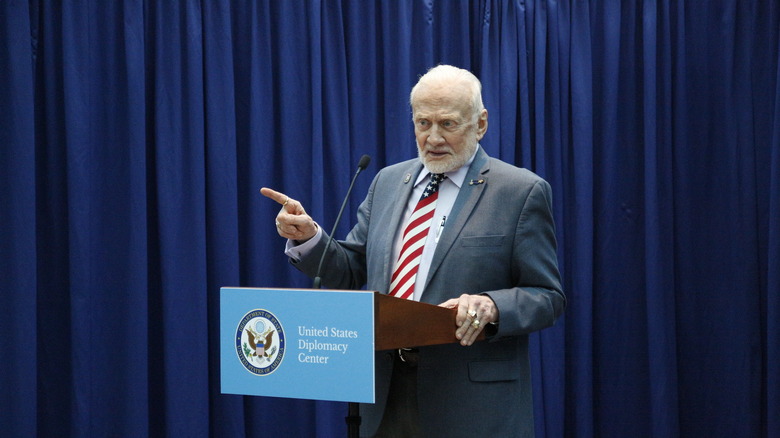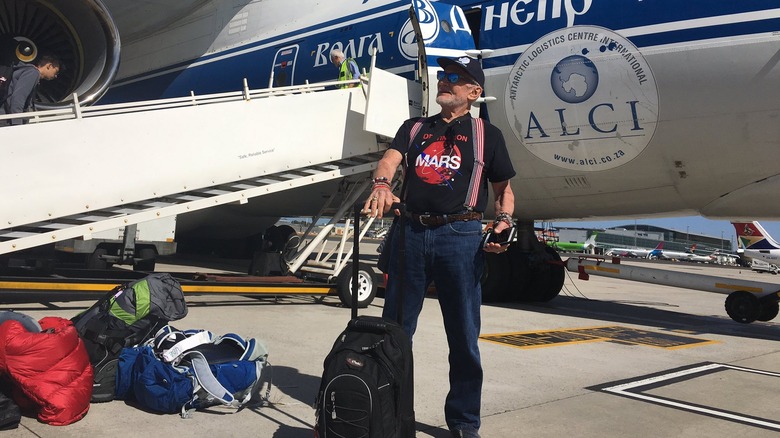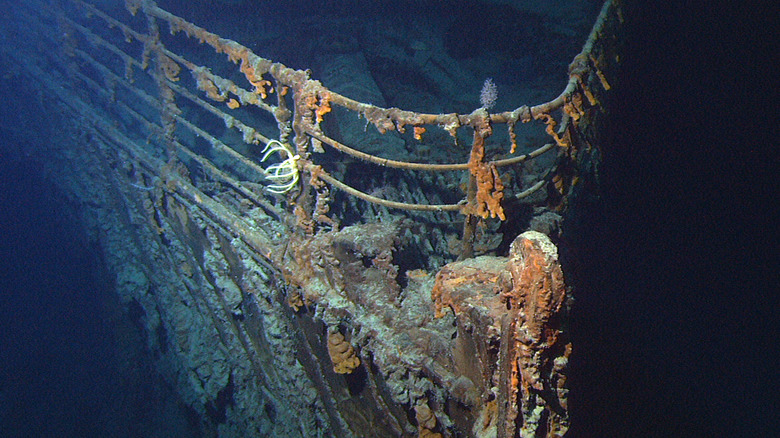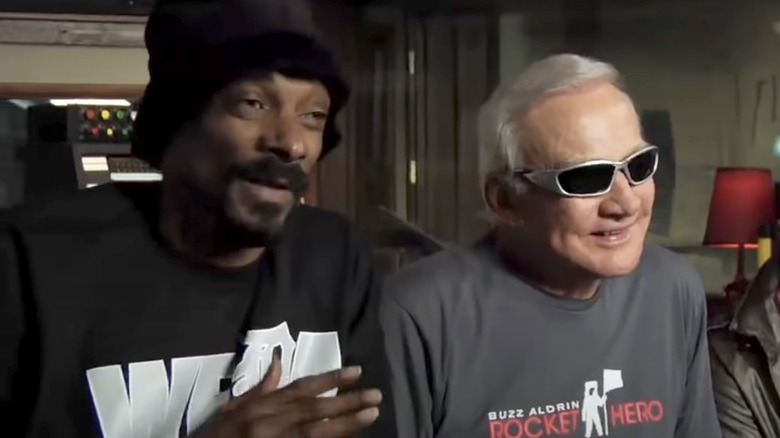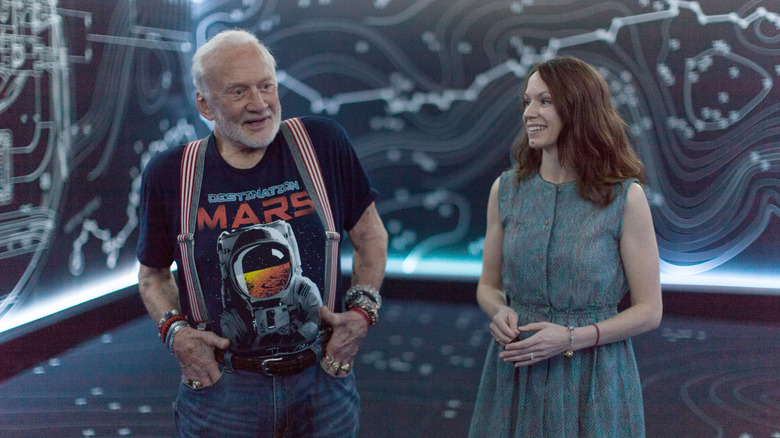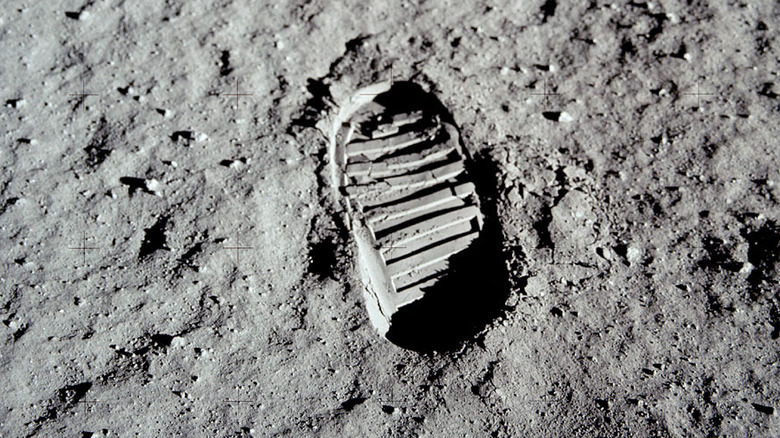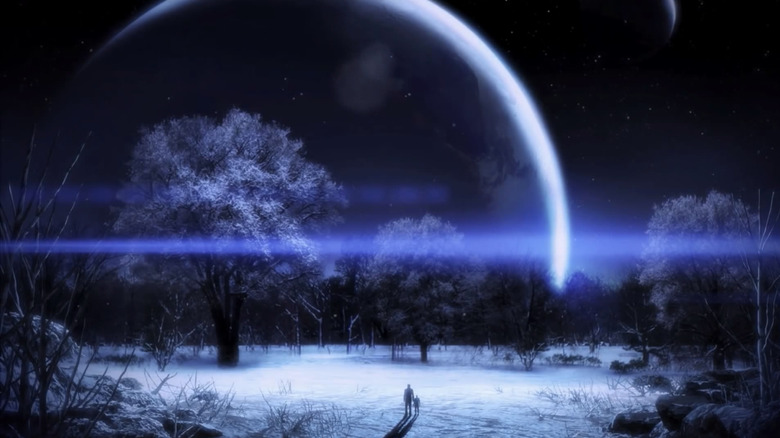The Untold Truth Of Buzz Aldrin
Throughout all of human history, only 12 people have ever set foot on the moon. Their small steps left a huge cultural footprint, cementing the historic Apollo missions as one of the greatest achievements humans have ever made. In 2023, NASA is in the process of sending astronauts back there for the first time in over half a century with the Artemis mission, and, with all things going to plan, it may mark the beginning of a whole new era of lunar exploration. As all eyes are on the astronauts making the 240-thousand-mile journey, many will no doubt remember Buzz Aldrin, the last surviving member of the famous Apollo 11 crew.
Buzz Aldrin has recently been in the news for getting married on his 93rd birthday. In his own words, he and his wife Anca were "as excited as eloping teenagers," highlighting that he's still something of a romantic even today. Given the many things he's accomplished over the years, this should come as no surprise. Aldrin has lived an exceedingly full life. As well as walking on the moon, he's earned a doctorate, flown fighter planes, traveled to both of Earth's poles, and cheated death on more than one occasion. A keen space exploration advocate and a true explorer, Buzz Aldrin's life is full of interesting stories.
His mother's maiden name was Moon
Sometimes, fate has a sense of humor. As Buzz Aldrin mentions in his book "Magnificent Desolation," his mother's maiden name was Marion Moon. It's a remarkable coincidence, and this is certainly not lost on Aldrin himself. On Mother's Day in 2015, he pointed it out in a Twitter post saying, "I guess it was destiny." Another little coincidence is that Aldrin's mother was born in 1903, the same year of the Wright Brothers' historic first flight. At the time, they probably couldn't have imagined that just 66 years afterward, there would be people traveling to the moon.
Aldrin was born in 1930, the youngest of three siblings, and although he was christened Edwin Eugene Aldrin Jr., he acquired the name of Buzz very early in his life. With two older sisters, his family began calling him, simply, "Brother." His sister Fay Ann, not much older than him, frequently mispronounced this as "Buzzer" which eventually became Buzz, the name which he'd be known by for the rest of his life. In 1988, he made it official and had his name changed legally, but at this point, it was essentially just a formality. In every way that matters, he's always been Buzz Aldrin.
[Featured image by Dlwilcox via Wikimedia Commons | Cropped and scaled | CC BY-SA 4.0]
He was nicknamed Dr. Rendezvous
Buzz Aldrin is a bona fide rocket scientist, with the qualifications to prove it. Academically minded, he completed a doctoral degree in astronautics in 1963, writing a thesis entitled "Line-of-sight guidance techniques for manned orbital rendezvous" all about docking spacecraft in space. Aldrin was clearly always enthusiastic about becoming an astronaut. He dedicated his thesis to all of America's present and future astronauts, adding, "If only I could join them in their exciting endeavors!" It wouldn't be long before he realized this ambition, joining the Gemini Project which inspired his work. Per the Smithsonian National Air and Space Museum, he was the first astronaut to hold a Doctor of Science degree.
His passion for the topic would earn him a nickname among his colleagues at NASA, who began referring to him as Dr. Rendezvous — a moniker that was sometimes affectionate and sometimes derogatory. NASA engineers have noted on the record that Aldrin's knowledge and understanding of orbital mechanics have always been remarkably deep, sometimes surprising them with things they hadn't even considered. During the Apollo 11 mission, he and Neil Armstrong even altered the flight trajectory when they were leaving the moon, for a more direct route to meet up with Michael Collins in lunar orbit. NASA's mission control specialists were confident enough in Aldrin's abilities that they were happy to work with his calculations, recognizing that he knew exactly what he was doing.
He took holy communion on the moon
While everyone knows that Buzz Aldrin was the second person to step onto the surface of the moon, fewer people might know that he also took some time to perform a religious rite there. A devout Christian, his first free moments on the moon were used to take holy communion. As he mentions in his book "Return To Earth," he'd requested to bring a couple of small packages with him, containing a communion wafer, a little wine, a small chalice, and a card with a Bible passage from the Book of John.
Aldrin's communion was downplayed in the news at the time. With NASA being a government agency, there were concerns about the separation of church and state, and a debate was still ongoing after the Apollo 8 astronauts read a passage from the Book of Genesis during their mission over Christmas. NASA clearly didn't want to further inflame the debate. Instead, Aldrin spoke a brief message back to Earth requesting a few moments of silent contemplation and gratitude from anyone listening in.
In taking holy communion, Buzz Aldrin is also the only astronaut to ever drink alcohol while off-world. Or at least, that's the official line on the matter. According to the rules, astronauts are banned from drinking alcohol while in space — though unofficially, astronauts have a track record of smuggling recreational drinks into orbit. Nonetheless, Aldrin is certainly the only person to do so while on the surface of another world.
He once got to shut down the LHC's particle beam
The Large Hadron Collider (LHC) at CERN in Switzerland is the world's largest scientific experiment. A 17-mile ring of superconducting magnets guiding a colossal particle beam which has given physicists new insights into the fabric of reality after confirming the existence of the Higgs boson in 2012. Shortly before this historic discovery was announced, Buzz Aldrin paid a visit to the experiment.
A scientist and an advocate for exploration, Aldrin's fleeting visit to CERN was completely unplanned. At the time, he'd been endorsing an ecological program run by General Motors and took the opportunity to do some scientific sightseeing. He was accompanied by his wife at the time, as well as singer Katie Melua, who'd been performing at the same event. While at the LHC, he met with lead scientists and was given a brief tour, ending with him being given permission to hit the big red button to shut down the particle beam and end an experiment. This process is technically known as dumping the beam — a way to safely dissipate the tremendous amount of energy the LHC's particle collider controls. The particle beam at CERN can carry the same kinetic energy as a Boeing 747, so safely operating it is an important task with a dedicated team of scientists. Few others have ever had the privilege to work the controls!
[Featured image by CERN | Cropped and scaled | CC BY-SA 4.0]
He's a sci-fi author
Buzz Aldrin's scientific background and journeys into space evidently gave him creative inspiration, and in 1996 he published a sci-fi novel. The book "Encounter with Tiber" is about a spacefaring historian en route to Alpha Centauri, the nearest star system to the Sun. The decades-long journey sees her translating two alien books and unraveling ancient mysteries. In the story, an alien civilization once lived around Alpha Centauri, but a threat of cosmic bombardment prompted them to start exploring nearby stars, leaving evidence behind that they'd once visited Earth.
In the hard sci-fi genre, no punches are pulled with scientific details, and "Encounter with Tiber" puts a strong emphasis on scientific accuracy. Having been published in the 1990s though, some of the finer details are now slightly outdated. It's clearly inspired by Aldrin's own journey to the moon, and the realization of many astronauts that a single planet looks surprisingly fragile in the empty vastness of space. It also has influence from his religious background, linking some passages in the Bible to his fictional extraterrestrial visitors.
Reviews of Aldrin's story are largely positive, with many readers praising the interesting plot and characters, although a few find the prose a little awkward in places. Some readers evidently find the technological descriptions a bit excessive, with plenty of details on engineering and spaceflight — but readers who enjoy that kind of writing, and Aldrin's eagerness for humanity to do more space travel, will doubtless love this story.
He nearly had a fatal plane crash
Being one of the few people to ever travel to the moon must certainly have taken no small amount of bravery, but this is something that Buzz Aldrin has never had a short supply of. During his pre-NASA days at the U.S. Air Force, he was something of a daredevil, but he nearly paid dearly for this. One incident, while piloting an aircraft, could easily have ended in disaster.
Aldrin, who was top of his class in his first year at the newly minted USAF Academy, had a passion for aviation. Air Force Magazine recounts the story of how he was eager to fly fighter planes, for the excitement and the skill required. The fateful incident happened in a T-28 trainer aircraft, a powerful plane, able to perform some impressive maneuvers but also lacking ejector seats.
Aldrin attempted a double Immelmann turn in this plane — a difficult combat maneuver, requiring precise control and involving some sharp accelerations. During his attempt, the G-forces proved too much for him causing him to suffer a greyout. He managed to recover in the nick of time and pull up just a few hundred feet away from the ground, avoiding a crash that he almost certainly wouldn't have survived. Notably, the Immelmann turn was a stunt that no one had performed before in a T-28 like the one Aldrin was flying.
He once punched a conspiracy theorist
Most people will likely have heard the story of Buzz Aldrin punching a moon landing denier in the face, but the full details of the story aren't told as often. The conspiracy theorist in question was a man named Bart Sibrel, who had already confronted Aldrin twice previously. The third time, however, was when he evidently took things too far.
Aldrin had been fooled into going to an interview at a hotel in Beverley Hills, where he'd been told he'd be appearing on a Japanese TV show. Not expecting any trouble, he'd also brought along his stepdaughter. Sibrel confronted him aggressively, cornering him and trying to force Aldrin to swear on a Bible that he'd never been to the moon — a twofold insult to a man who'd made a point of reading Bible passages while he was there. Aldrin's punch was in self-defense, and out of fear for his stepdaughter's safety.
Cameras caught the punch, as BBC News reports, as well as recording Sibrel pursuing Aldrin, calling him a "thief, liar and coward." No charges were ever pressed against Aldrin for the incident. As well as acting in self-defense, Sibrel sustained no significant injuries and Aldrin's record was perfectly clean. While Sibrel's false claims about the moon landings make no sense and have been debunked many times over by a variety of experts, he still insists that he's correct to this day. Evidently, though, he hasn't been foolish enough to confront Buzz Aldrin a fourth time.
He was the oldest person to visit the South Pole
In 2016, Buzz Aldrin set off on an expedition to Amundsen-Scott Station at the South Pole, publicizing the event himself on Twitter. The journey, however, would not go according to plan. Aldrin was 86 at the time and developed altitude sickness. His journey had to be cut short as his health worsened, becoming severe enough that he needed to be evacuated. Per The Washington Post, even though he nearly died, he insisted the journey had been worth the risk. Before the evacuation, his attitude had been that "when turning back is about as difficult as pressing on, you press on because you've got an objective."
Even cut short, the journey gave Aldrin the record for being the oldest person ever to travel to the South Pole. After previously visiting the North Pole in 1998, he's also the oldest person ever to visit both of Earth's poles. Despite his ordeal, Aldrin remained in high spirits throughout the entire thing, recounting the experience fondly. The main reason for his visit was to speak with scientists doing research on travel to Mars — in many ways, travel to Antarctica is the next best thing to actually visiting another planet. In an amusing coincidence too, Aldrin was treated by a doctor named David Bowie. The namesake of the famous musician seems a fittingly named physician to treat a true Starman.
He visited the Titanic
As well as traveling to the surface of the moon and both of Earth's poles, Buzz Aldrin has also visited one other place that seems eerily like another world. The depths of the oceans. In 1996, as the Orange County Register reports, visited the sunken wreckage of the Titanic in a mini-submarine. A cramped little vehicle that was likely quite reminiscent of the lunar lander Aldrin had previously traveled in. The ruins of the huge passenger ship lie in a remote part of the Atlantic Ocean, some 400 nautical miles from Newfoundland and around 12,500 feet below the waves. Difficult to reach, and even more difficult to see in the darkness of the deep ocean, Aldrin reportedly found the experience captivating.
It's a popular myth that we know more about the surface of the moon than we do about the floor of the ocean, but that isn't entirely true. All the same, few people have ever been to the deepest, most inaccessible reaches of our planet. Aldrin has been to both, noting that while the deep sea may have been a surreal place to visit, it was "not as unusual as what I saw while walking on the moon."
He once made a rap video with Snoop Dogg
To commemorate the 40th anniversary of the Apollo 11 landing, Buzz Aldrin made a rather unconventional choice. He collaborated in a rap video with Snoop Dogg! Per MTV, Aldrin worked together with Snoop Dogg and Talib Kweli, making a video directed by Terminator: Salvation's McG. Also involved in the project were Soulja Boy and Quincy Jones.
79 years old at the time, Aldrin's goal in the project was to stoke enthusiasm for space travel among younger audiences. The video was also made to raise money for his charity foundation ShareSpace, which promotes science education for young children. The song itself, "Rocket Experience," may seem like an oddity, but it's a catchy little tune and everyone involved clearly had a good time making it. Aldrin also uploaded a short making-of video to his YouTube channel, featuring him saying, "I have only two passions: Space exploration and hip-hop." The video ends with a little freestyle from Snoop, about traveling into space.
He invented a better way to get to Mars
Buzz Aldrin has always been an advocate for sending astronauts to Mars. In fact, he quite literally wrote the book. "Mission to Mars" explains his vision in detail, giving a full plan for how to both send a crew to Mars and then establish a permanent outpost there. Complete with his own hand-drawn diagrams, it's an inspiring read, drawing praise from numerous high-profile voices including Stephen Hawking and James Cameron. Aldrin's always been vocal about going to Mars. As he wrote in a New York Times Op-Ed, in his view, the moon is not a destination but a jumping-off point for longer journeys into space.
One of Aldrin's biggest contributions towards traveling to Mars is devising a better means to get there. Interplanetary travel isn't a straightforward task. Journey times are long and everything is constantly in motion, needing spacecraft to travel in huge arcs as they navigate the gravitational forces of both the planets and the Sun itself. The trajectories involved are known as cyclers, using a kind of predictable transitory orbit that can easily send vehicles on interplanetary journeys. Aldrin developed the theory and devised his own trajectory, known as the Aldrin Cycler, providing a faster and more efficient way to travel between Earth and Mars. His grand ambition was to make it possible for regular flights between planets.
[Featured image by NASA Kennedy via Flickr | Cropped and scaled | CC BY-SA 2.0]
A crater on the moon is named after him
To immortalize his name and commemorate the historic Apollo 11 mission, a crater on the moon bears Aldrin's name. Per Sky & Telescope magazine, Aldrin's crater sits alongside two others, named after his fellow crew members, Neil Armstrong and Michael Collins. They're found in the Sea of Tranquility, one of the dark patches of the moon's surface visible from Earth, and the same region where Apollo 11 touched down. The craters are quite close to the original landing site where Buzz Aldrin and Neil Armstrong set foot. With a diameter of just under 2 miles, it's even possible to see the crater from Earth with a good telescope.
As well as the moon crater, Buzz Aldrin also has an asteroid named after him. The NASA database lists asteroid 6470 Aldrin as a main belt asteroid first spotted in 1982. Asteroid names are given by the International Astronomical Union, often in recognition of scientific work and accomplishments — an honor that Aldrin shares with other historic scientists like Isaac Newton, Stephen Hawking, and Nicolaus Copernicus.
He made a cameo in Mass Effect 3
In the 21st century, Buzz Aldrin is a pop culture icon. As well as public speaking and space travel advocacy, he's made a few notable cameos in TV and movies, including "The Simpsons," "Futurama," and "Transformers: Dark of the Moon." Famously, the character Buzz Lightyear from the "Toy Story" movies is also named in his honor. Perhaps his most poignant cameo appearance though, is in an ending scene for Bioware's "Mass Effect 3."
The ending of the "Mass Effect" video game trilogy was controversial, with the player forced to make a choice leading to one of several different endings. One of the hidden options, known as the "perfect" ending, finishes the game with a short epilogue scene. In it, a character known as the Stargazer waxes poetic, saying, "Our galaxy contains billions of stars. Each of those stars could have many worlds. Every world could be home to a different form of life. And every life is a special story of its own." The voice behind the Stargazer is Buzz Aldrin, and given his passion for space travel, it's easy to imagine he genuinely believes every word he says.
